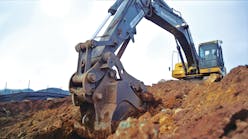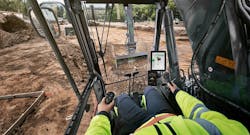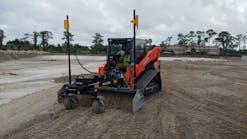Desperate for Data? New Standard API for Telematics Integrations Shows Promise
Liz Quinn, product marketing manager with John Deere’s WorkSight technology program, says that contractors are ready for an API standard that lets them easily integrate data from multiple sources and manage the numbers they need to efficiently manage their equipment.
“It’s a commonly voiced customer need. They want to view the numbers from all of their assets in the same place,” says Quinn. “I view the standardization of API as a first step. It’s a foundational step to be able to actually integrate data from multiple sources and still make sense of it, an input into the development of a dashboard that allows you to analyze data from multiple brands of equipment. Contractors want the ability to compare and manage their assets from a common operating model.”
Liz Quinn, product marketing manager with John Deere’s WorkSight technology program, says that contractors are ready for an API standard that lets them easily integrate data from multiple sources and manage the numbers they need to efficiently manage their equipment. “It’s a commonly voiced customer need. They want to view the numbers from all of their assets in the same place,” says Quinn. “I view the standardization of API as a first step. It’s a foundational step to be able to actually integrate data from multiple sources and still make sense of it, an input into the development of a dashboard that allows you to analyze data from multiple brands of equipment. Contractors want the ability to compare and manage their assets from a common operating model.” [text_ad] As product marketing manager, Quinn holds several focus groups every year. At every one of these groups, she says, end users tell her that they are desperate for a way to analyze their machines’ idle time, fuel consumption, trouble codes, and work hours from one central application. That’s what the API can enable if the contractor and their IT manager take the steps to integrate that standardized data into their system of choice. “I don’t have one conversation or focus group where the need for a standard is not voiced, and not voiced with enthusiasm and passion,” says Quinn. “They want to know how we can make this happen.” Having original equipment manufacturers (OEMs) provide a standardized data feed, though, is just the first step in allowing contractors to analyze information from all machines through one application, says Quinn. It’s an important step, but far from the final one. Once the OEMs provide the standardized data feed, companies such as third-party portal providers and suite-management software firms must grab that API data feed and write their own code to integrate the data into their systems, says Quinn. For instance, John Deere is making the API accessible at http://developer.deere.com. It is then up to IT departments or vendors to connect their customers’ data to the common system of their choice, says Quinn. How far, then, is the industry from a time in which the majority of contractors and owners will be accessing telematics data for all of their machines from one application? Quinn says that the industry will be closer to this goal when the API standard is available than ever before. “That holy grail is not as far away as it was before the standard,” says Quinn. “My crystal ball tells me that it will take another year or so, though, for even the majority of larger contractors to get their arms around integration. It will take them time to define the details and the requirements, how they want to see that standardized data, what their preferred back office will be. How long will all that take? It’s hard to say.” This leads to the big question: Why didn’t a greater number of contractors adopt version 1.0 of the API standard? Part of the problem was a lack of education over how integration works, says Quinn. Many contractors were never taught how to get started with using the API standard. At the same time, that original version 1.0 of the API standard only included those four basic data points. That wasn’t enough useful information to persuade many contractors to tackle the learning curve associated with integrating the standard API stream into their operations. Others didn’t want to tackle integration when they knew that a second, more comprehensive API standard was eventually going to be introduced. “They didn’t want to go down the path when they knew that they were going to have to do it again once the expanded API standard came out,” says Quinn. “They didn’t want to take the plunge with tech that they worried they were just going to have to replace anyway.” There is hope that more contractors will embrace version 2.0 of the API standard. The new standard contains so many more data points, and telematics itself has strengthened its hold on the construction industry. [text_ad use_post='27747'] There are fewer reasons, then, for contractors to resist taking the steps necessary to create a single point of access for telematics data from all of their construction vehicles, says Quinn. “There is more confidence now that this version will provide more value,” says Quinn. “Customers are more confident that by adopting this standard it will deliver value to their organizations.” Today, contractors must jump between three and four websites to monitor their construction vehicles, says Quinn. If they can instead centralize all of their data into one application, they can increase their efficiency. They won’t have to log onto one website to check the idle time of a John Deere machine and then log onto another to determine how much fuel was consumed by a machine manufactured by Caterpillar. Instead, they can log onto one site to determine that it makes more sense to send one of their machines to a different job site or schedule maintenance on another. “This is the trend of the future,” says Quinn. “Our customers should have confidence in investing in integration.”As product marketing manager, Quinn holds several focus groups every year. At every one of these groups, she says, end users tell her that they are desperate for a way to analyze their machines’ idle time, fuel consumption, trouble codes, and work hours from one central application.
That’s what the API can enable if the contractor and their IT manager take the steps to integrate that standardized data into their system of choice.
“I don’t have one conversation or focus group where the need for a standard is not voiced, and not voiced with enthusiasm and passion,” says Quinn. “They want to know how we can make this happen.”
Having original equipment manufacturers (OEMs) provide a standardized data feed, though, is just the first step in allowing contractors to analyze information from all machines through one application, says Quinn. It’s an important step, but far from the final one.
Once the OEMs provide the standardized data feed, companies such as third-party portal providers and suite-management software firms must grab that API data feed and write their own code to integrate the data into their systems, says Quinn.
For instance, John Deere is making the API accessible at http://developer.deere.com. It is then up to IT departments or vendors to connect their customers’ data to the common system of their choice, says Quinn.
How far, then, is the industry from a time in which the majority of contractors and owners will be accessing telematics data for all of their machines from one application? Quinn says that the industry will be closer to this goal when the API standard is available than ever before.
“That holy grail is not as far away as it was before the standard,” says Quinn. “My crystal ball tells me that it will take another year or so, though, for even the majority of larger contractors to get their arms around integration. It will take them time to define the details and the requirements, how they want to see that standardized data, what their preferred back office will be. How long will all that take? It’s hard to say.”
This leads to the big question: Why didn’t a greater number of contractors adopt version 1.0 of the API standard?
Part of the problem was a lack of education over how integration works, says Quinn. Many contractors were never taught how to get started with using the API standard. At the same time, that original version 1.0 of the API standard only included those four basic data points. That wasn’t enough useful information to persuade many contractors to tackle the learning curve associated with integrating the standard API stream into their operations.
Others didn’t want to tackle integration when they knew that a second, more comprehensive API standard was eventually going to be introduced.
“They didn’t want to go down the path when they knew that they were going to have to do it again once the expanded API standard came out,” says Quinn. “They didn’t want to take the plunge with tech that they worried they were just going to have to replace anyway.”
There is hope that more contractors will embrace version 2.0 of the API standard. The new standard contains so many more data points, and telematics itself has strengthened its hold on the construction industry.
There are fewer reasons, then, for contractors to resist taking the steps necessary to create a single point of access for telematics data from all of their construction vehicles, says Quinn.
“There is more confidence now that this version will provide more value,” says Quinn. “Customers are more confident that by adopting this standard it will deliver value to their organizations.”
Today, contractors must jump between three and four websites to monitor their construction vehicles, says Quinn. If they can instead centralize all of their data into one application, they can increase their efficiency.
They won’t have to log onto one website to check the idle time of a John Deere machine and then log onto another to determine how much fuel was consumed by a machine manufactured by Caterpillar. Instead, they can log onto one site to determine that it makes more sense to send one of their machines to a different job site or schedule maintenance on another.
“This is the trend of the future,” says Quinn. “Our customers should have confidence in investing in integration.”










